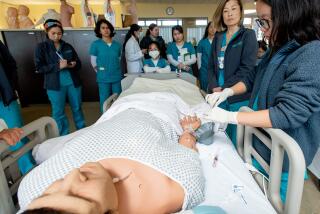Curricula Unequal : CSU Standard Can Be Met, Schools Say
School administrators said Wednesday that any San Fernando Valley 10th-grader with an eye toward college should have no problem getting courses needed to meet toughened California State University entrance requirements.
But officials of the Los Angeles Unified School District conceded that, when it comes to offering college prep courses, schools are not equal.
“Technically, all schools should offer the same courses,” said Jackie Goldberg, the Los Angeles school board member who chairs the board’s Educational Development Committee. “But in reality a lot of schools only have one or two advanced courses, while other schools have more than a dozen in just one subject area. We are not providing the same quality of education in all parts of the district.”
This equity issue was pushed into the spotlight Wednesday when CSU trustees gave final approval to the new entrance requirements.
Current Standards
Under requirements that took effect last year, students wanting to attend CSU schools must have four years of English and two years of math and must be in the top third of their high-school graduating classes.
The new standards, which will take effect in fall, 1988, require an additional year of math, a year of U.S. history or government, a year of science, two years of foreign language, a year of visual or performing arts and three years of academic electives.
Critics of the tougher CSU requirements argued that schools with large minority enrollments often do not offer the advanced courses that it will take to get into the state universities. But principals and counselors at predominantly minority high schools in the Valley said that isn’t the case. They said they are offering the courses that college-bound students need to take, although including the classes in the curriculum is sometimes difficult.
“We have to make allowances so that we can offer courses for kids who are college-bound,” said Ernest Scarcelli, principal of Sylmar High, where minority group members make up 60% of the student body. “That might mean that, in order to free up a teacher to teach math analysis to 15 students, we might have to have more than 35 students in a basic math class. But it’s worth it so that college-bound students have the classes that they need.”
Jane Godfrey, principal of Van Nuys High School, where 58% of the students are from minority groups, said that “by hook or by crook” her staff makes sure that the necessary academic courses are available.
Beth Lawery is head counselor at San Fernando High, where minority members make up more than 95% of the student body. When counselors visit neighboring junior high schools, she said, they stress that San Fernando’s curriculum features a complete college prep program, including honors and advanced courses.
But, whereas San Fernando’s program features only one physics class, Granada Hills High, with a minority enrollment of less than 40%, has several sections of physics. That means that, if a San Fernando student wants to take physics but the class time conflicts with another required course, the student may be forced to forgo the advanced science class. At Granada, the student has a choice of class times, making it easier to take physics.
“To be able to offer advanced courses at some minority schools, the staff has to take away teachers and resources from another part of the program,” said Rudy Acuna, a California State University, Northridge, professor who is a critic of the new CSU system requirements.
“This is not fair to minority students and places them at a disadvantage when they begin the college admission process.”
Extra Teachers
The Los Angeles school district has grappled with trying to find ways to equalize advanced course offerings at its schools. Dan Issacs, superintendent of the Senior High Division, said one method is to assign extra teachers to schools with small enrollments or where priority is given to remedial classes, so that advanced courses can be offered.
But, during budget hearings this summer, a request for $481,666 for 426 additional advanced classes at junior and senior highs that otherwise could not offer the classes was not considered by the entire school board. Board members said it was determined that the district could not afford the added expense.
“There is a vast difference in the course offerings at different schools,” Goldberg said. “And we have to continue working to close the gap.”
More to Read
Sign up for Essential California
The most important California stories and recommendations in your inbox every morning.
You may occasionally receive promotional content from the Los Angeles Times.









